In 2019 I went to Maui with my boyfriend Dominique, and among the exciting and touristy things we did was visit the lunchy restaurant Tin Roof. Helmed by Top Chef finalist Sheldon Simeon, the place is about the size of a walk-in closet and focuses on that staple of the fast-casual experience: bowls (or, as they’re called on the menu, kau kau tins — a reference to the lunchboxes plantation workers in Hawaii relied upon for meals). I was prepared for a tasty meal, but I did not anticipate the flavor bombs that were about to go off. The Mochiko Chicken was pure insanity — fried chicken thighs marinated in shoyu (a.k.a. soy sauce) and topped with miso and gochujang sauces, among other things. I gilded the lily by adding garlic noodles that were so potent I felt like I was breathing toxic fumes for a full week afterwards. The whole lunch, while simple, has lingered in our brain spaces ever since — especially for Dom, who periodically will note, “That chicken in Maui? That shit was sooo good.”
Enter the global pandemic. Nothing like home confinement to make the heart grow fonder for Maui (although… Maui does a good job of that on its own). That’s why when Sheldon Simeon’s cookbook Cook Real Hawai’i hit shelves last year, it was an insta-purchase for me. My goal was to make the Mochiko Chicken and garlic noodles. If I could pull off a fraction of Tin Roof’s magic, it would be a worthwhile cookbook purchase.
But I’m not here to talk about Mochiko Chicken. Why? Because after having owned the book for over a year, I’ve still never made it. I’m a little intimidated — I’m not great at frying chicken to be honest. But also, life (and other cookbooks) got in the way. It happens.
Then my luggage broke. Somewhere in the Albuquerque airport last week, the wheel on my rollerboard jammed up stubbornly, causing enough of a hassle that I fast-tracked a repair as soon as I returned home. Conveniently, the luggage guy was just a few blocks from LA’s “Little Osaka” neighborhood on Sawtelle, and because my brain works this way, I began creating a plan: I could drop off the bag, then go to Carvel across the street (an important part of any scheme; although not very integral to this story), and then go to the Japanese supermarket afterwards. Awesome! But what’s the point of buying Japanese ingredients if I don’t know what to do with them?
Cook Real Hawai’i popped into my head. Since so many Hawaiian dishes rely on Japanese ingredients, I felt confident that one of Sheldon Simeon’s recipes would justify my visit to the Nijiya Market on Sawtelle. However, I did not gravitate towards his Mochiko Chicken or even his garlic noodles but instead something that had intrigued me ever since I first leafed through the cookbook: Pan Sushi Dynamite.
Described as “a sushi roll without the rolling” and “sushi casserole,” this baked dish promised something very important to me: a sushi-like experience with the fun of a one-pan dinner. The real draw, however, was the photo — a bed of rice topped with charred, mayo-swirled salmon, and garnished with a brown glaze and slices of avocado. I don’t know why I was so entranced by this photo, especially since creamy, baked sushi is not normally what I ever lean towards (I can count the number of times I’ve ever ordered a volcano roll). But there was something about this sushi bake that I couldn’t turn away from. It was either going to be the best thing ever or an epic disaster.
I decided it was time to take the plunge. My apologies to Dom: half the reason I bought the book was to make him his beloved Mochiko Chicken, but tonight I was boarding the Pan Sushi Dynamite rollercoaster instead.
I returned from Nijiya Market with some fun items: sheets of nori, Kewpie mayo, masago (capelin fish roe), and a box of Pocky, among other things. The Pocky had nothing to do with the Pan Sushi Dynamite and everything to do with my lack of self-discipline. The one thing I didn’t return with: sushi-grade salmon. The recipe called for a full pound, which would have been expensive; so instead I picked up some salmon at my neighborhood supermarket instead. I figured it was an okay move since this wasn’t a raw dish but rather something that goes under the broiler. Besides, the recipe doesn’t even call for top-grade sushi quality. Still, it was admittedly a weird flinch – especially given that I was literally making sushi – and in the future, I will chalk up the extra cash to get the sushi-grade fish. Sometimes I don’t understand the choices I make. I blame my Carvel-addled brain.
Now it was time to make this crazy recipe. What would follow would be a series of minor setbacks and errors that would ROCK me to my core. Again, I blame the Carvel. Nothing in Sheldon’s recipe was particularly hard, but there were a few pre-recipe processes that needed to be addressed.
To start off, I needed four cups of warm, cooked white rice. Sounds simple enough… except I’m really bad at doing simple things sometimes. Turns out I didn’t have basic, short-grain white rice. Just jasmine rice. Oh God. I was already tinkering with the foundation of my sushi casserole. I told myself that I would survive a simple rice swap-out and tried not to fixate on this being an imperfect recreation of the recipe. But I was stressed.
I then loaded the jasmine rice into my tiny rice cooker. My gut told me that I only needed two cups of dried rice, but my paranoia sent a third cup in. This led to a near Strega Nona disaster scenario as the rice puffed up so much that I was afraid it would tumble out onto the countertop and consume my entire kitchen. Luckily, the rice behaved itself, even if the grains did press up against the glass lid as if they were standing outside the Today show windows.
While the rice created drama, I set to work creating a Sweet Soy Glaze. I am generally opposed to sub-recipes, but this one was simple enough: boil soy sauce and sugar together and then add cornstarch. I basically cooked it down to a thick syrup – or a glaze, as per its name. This sauce proved to be a great reminder of what I had loved about Tin Roof: intense sweetness perfectly counterbalanced by an aggressive saltiness. Not a lot of subtlety – just a wallop of flavor. An optimistic harbinger of what was to come, I hoped.
It was then time to prep the next batch of ingredients. I needed to heat a simple solution of vinegar, sugar, mirin, and salt that I would then mix with my rice. No problem! I would just reach into my pantry and pull out my LACK OF RICE VINEGAR. Had I really gone to a Japanese market and not acquired rice vinegar?? The answer is yes. Time for yet another substitution. What you need to know about me is that I hate making subs when I first cook a recipe. I want to be as precise as possible so that I have a fairly accurate approximation for how the final product should taste. But here I was, about to swap out vinegars (and let’s not forget the Jasmine Rice fiasco). I might as well be cooking a whole other dish.
I told myself told calm down and just use my alleged instincts. I needed something mild; so I subbed in rosé vinegar (yes, I have rosé vinegar, and it hails from my friend Rodrigo’s vinegar company American Vinegar Works. You all should go check out his stuff!). Little did I realize that there was a fully unopened bottle of rice vinegar six inches away in the non-vinegar region of my shelf. Lesson to be learned: use your eyeballs if you have them.
Into the saucepan went the vinegar, the sugar, and the mirin. I then scooped up a teaspoon of kosher salt and nonchalantly added it to the glaze. NO! NOT MY PERFECT GLAZE! It was meant for the vinegar solution! I acted quickly: scooping out the mound of salt with a spoon, taking a good portion of the glaze with it. Disaster was largely averted, but I was deeply rattled.
Next I tossed the rice with the vinegar and then pressed it into a cake round. The recipe called for a 9inx9in baking pan, but I only had an 8x8. I figured a 9in cake round might be a decent alternative, but had I done some basic math, I would have realized that a 9inch cake round actually has slightly LESS volume than an 8in x 8in pan. I clearly was still shooketh by the salt incident.
Nevertheless, I bumbled forward, making a slimy mixture of chopped salmon (non sushi grade, as you may remember), diced onion, diced shiitakes, soy sauce, sambal oelek, Thai sweet chili sauce, oyster sauce, toasted sesame oil, masago, and one cup of mayo. It looked not unlike an ambrosia salad, which was not terribly appealing to me, but I trusted that this would go in the right direction.
I spread the squishy mixture all over the rice and stuck the whole thing under the broiler. The recipe calls for the pan being six inches away from the fire, which I thought I had done, but maybe not? Within four minutes, the salmon layer was already turning bright orange and had several charred sections — sort of like a kimchi pancake. Was it done?
I pulled the pan from the oven and inspected. It certainly looked cooked… but maybe it was still raw below the surface. Had I only purchased sushi-grade salmon, I wouldn’t have cared. But this was just standard supermarket salmon. Was I setting myself up for poisoning? Should I have lowered the oven rack more? Would the fish have cooked more evenly had I used a larger pan?
I was riddled with self doubt; so I shoved the pan back under the broiler for two more minutes. I prayed to the kitchen gods that nothing would catch on fire, and thankfully they spared me any further chaos. I pulled the pan from the broiler and was happy to see that it still looked presentable – perhaps even… beautiful? All that was left was to top it all with some sliced avocados, scallions and the famous Sweet Soy Glaze I had made and subsequently sullied.
As per the recipe’s instructions, I sliced nori sheets into squares to serve with the Pan Sushi Dynamite and then sat myself down to try this madness. I couldn’t help but be proud of the final product, which, with its sliced avocados fanning out on top of each other, resembled an edible Sydney Opera House. That’s a good thing! The point is that the dish was beautiful and inviting — so much so that I was able to overlook that awkward moment when I realized I had cooked an entire potluck casserole for my solo enjoyment.
Time to try it. I took a heaping spoonful of rice, salmon, avocado, glaze, and scallions and placed it into a nori square. It’s like I knew exactly how it would taste, and yet there were still so many question marks hanging over it. Would it taste like a volcano roll? Would the flavors actually work? Was I poisoning myself?
Any doubts or concerns evaporated the moment I took my first bite. Literally blown away. Just like the lunch I’d enjoyed at Tin Roof, this dish practically punched me in the face with intense flavors: sweetness, saltiness, umami…ness(?). The char from the broiler added a light smoky note but also a firmer texture that stood in contrast to the soft layers of avocado, rice, and salmon. Perfect. Meanwhile, the nori, while seemingly just a vessel, provided additional crispiness that shouldn’t be overlooked. To wit, the next day I heated up some leftovers in a bowl and ate it with chopsticks poki style. I sorely missed the snap of the handheld nori wrapper.
Honestly my only reservation with the dish was about the safety of the salmon. I suspected it was fine to eat, but as I approached the center of the pan, the chunks salmon that hadn’t been exposed to the broiler became rarer and rarer. I know it’s a fish that can be served incredibly rare, but when using a non-sushi grade fillet, I wasn’t sure how much leeway I truly had. Next time I make this dish — because I am definitely making it again — I will experiment with lowering the rack under the broiler (so that the pan cooks longer before browning) or even following Sheldon’s other suggestion: using canned salmon instead (the horror! But also, given the amount of mayo and condiments in this dish, I suspect canned salmon will work just fine).
Salmon anxiety be damned, I could not believe just how delicious this Pan Sushi Dynamite was. But of course it was delicious! Pan Sushi Dynamite has earned a spot on my potluck list, and I look forward to playing around with other fun toppings such as sriracha, spicy mayo, and various other condiments. Oh, and importantly, I did not poison myself! At least not yet.
Check out the full recipe here.




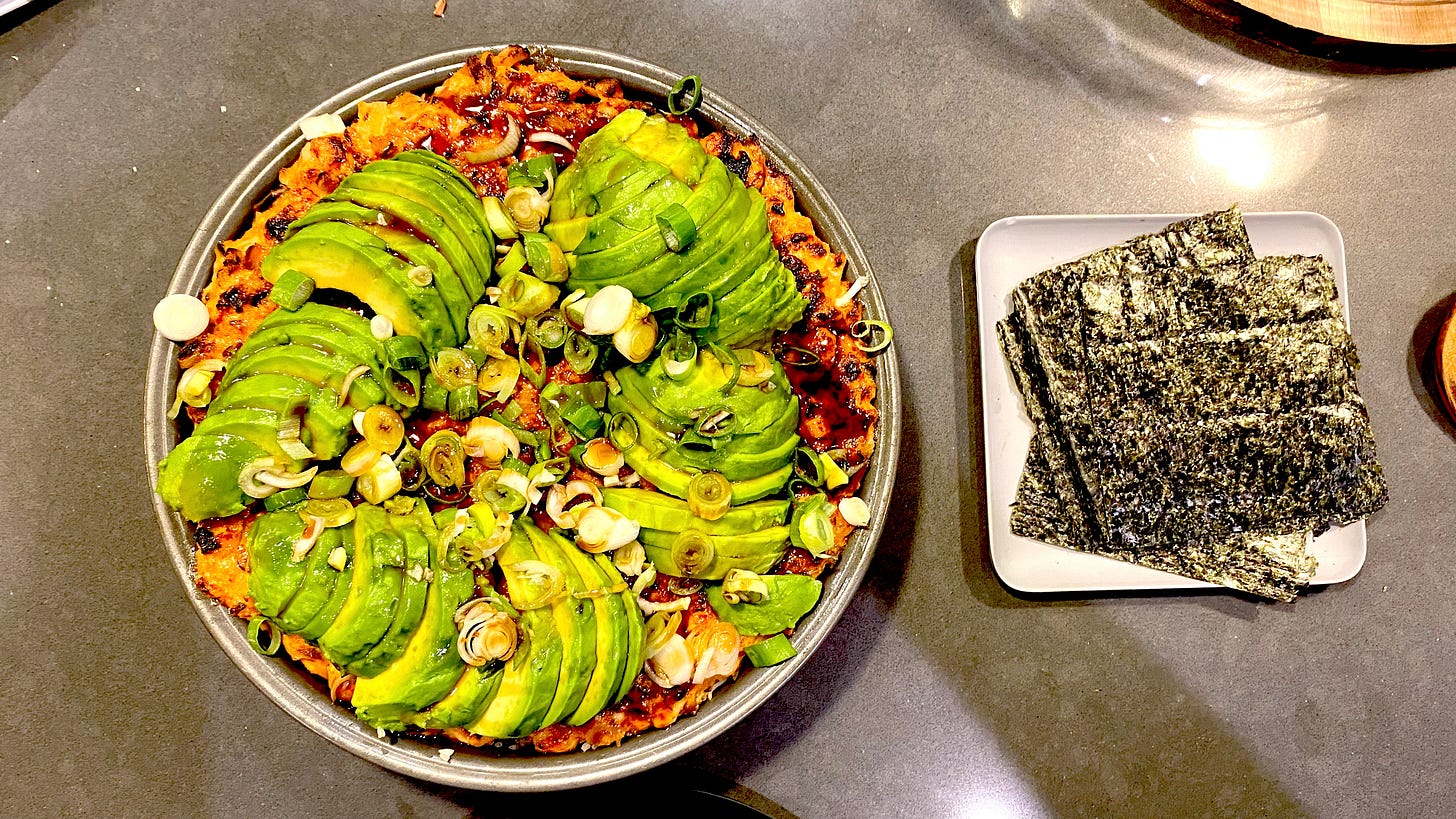
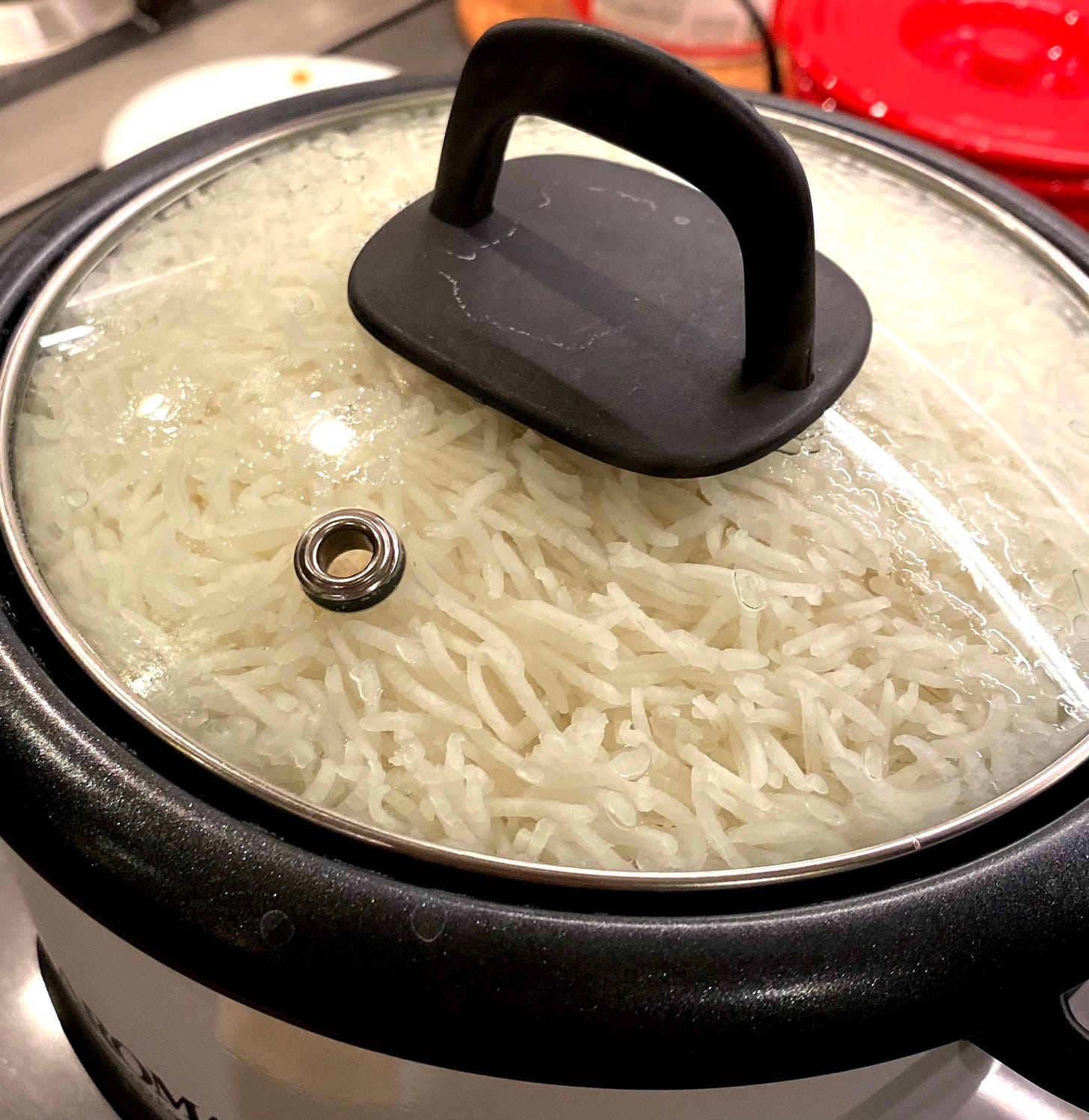
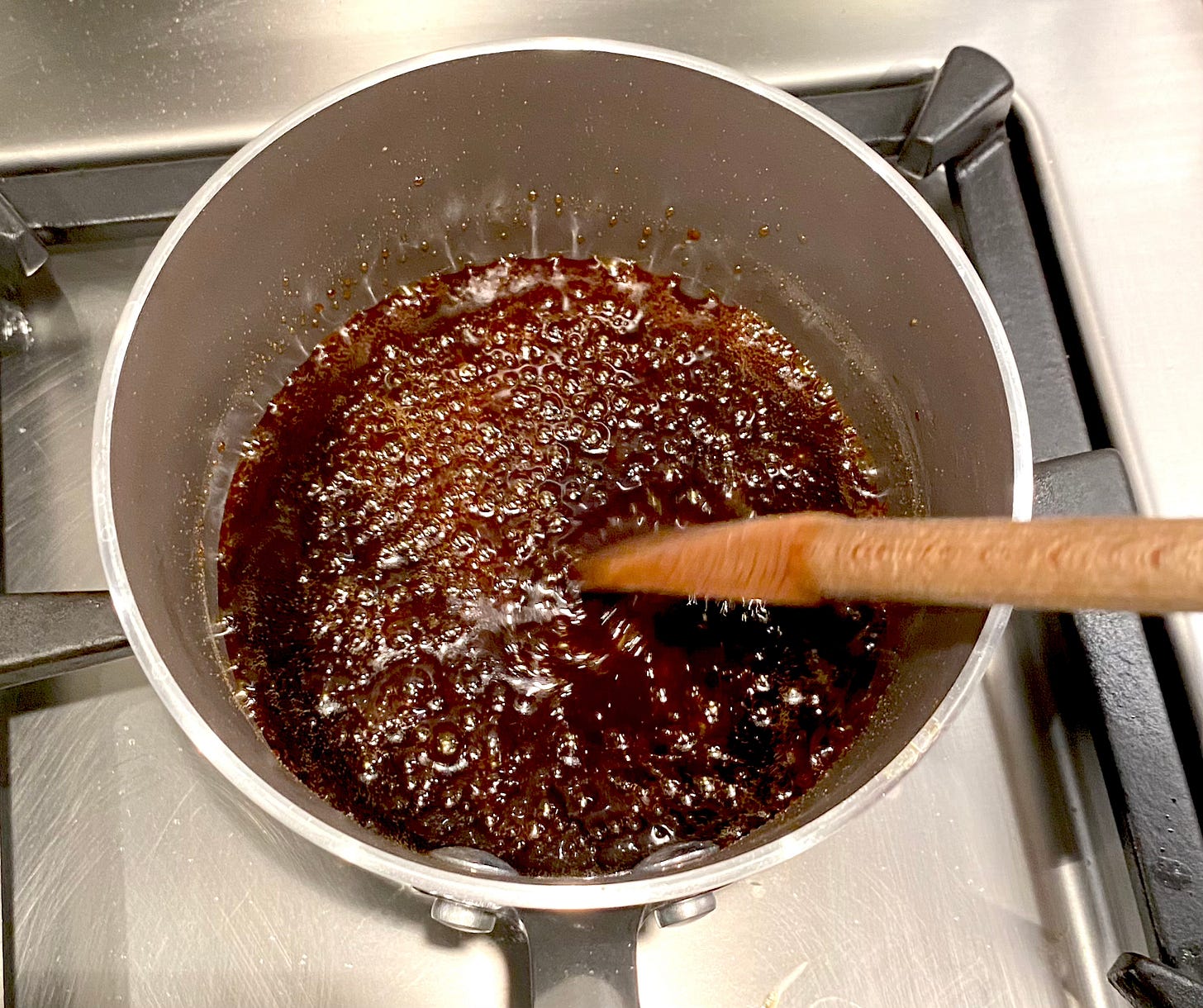

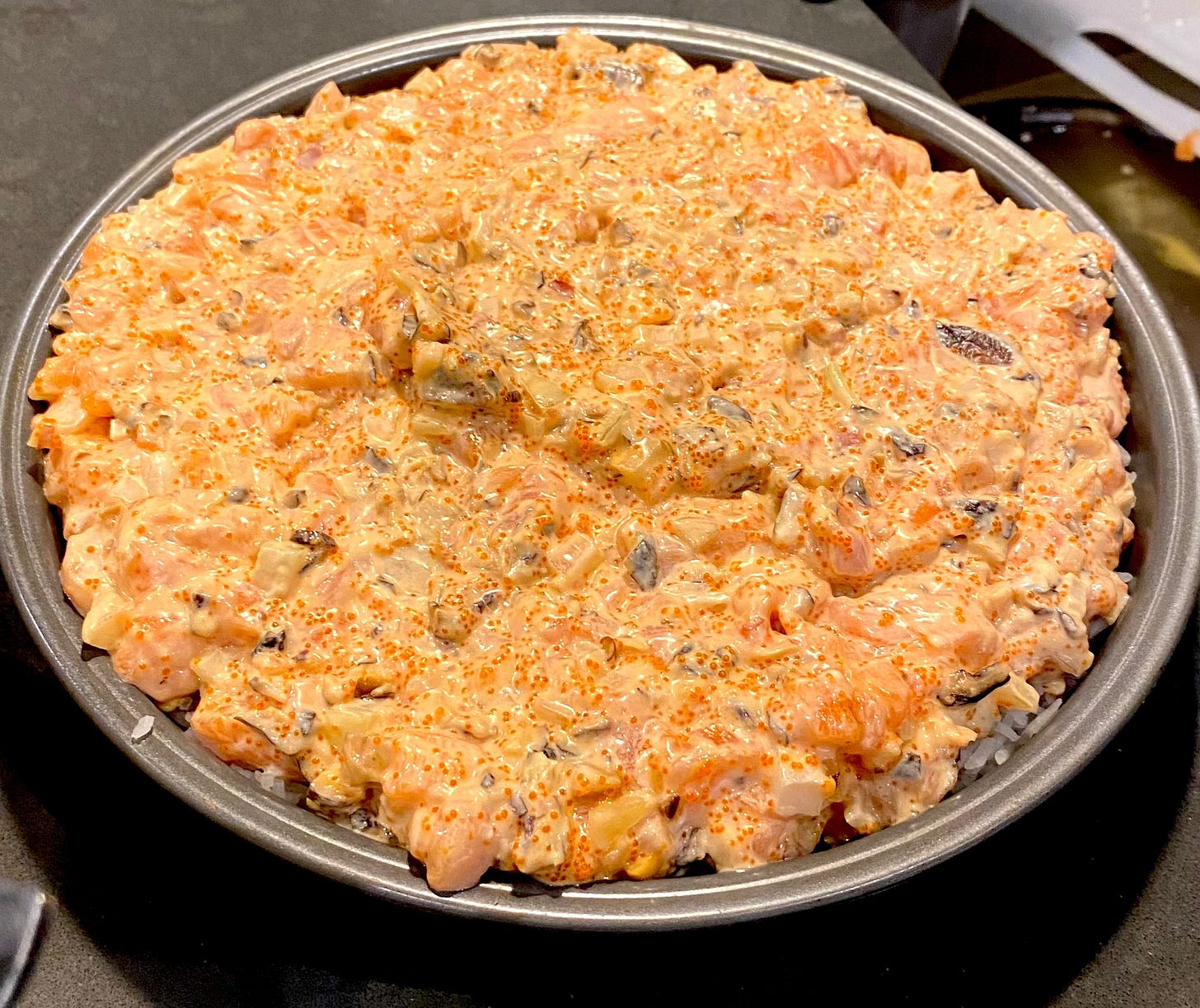
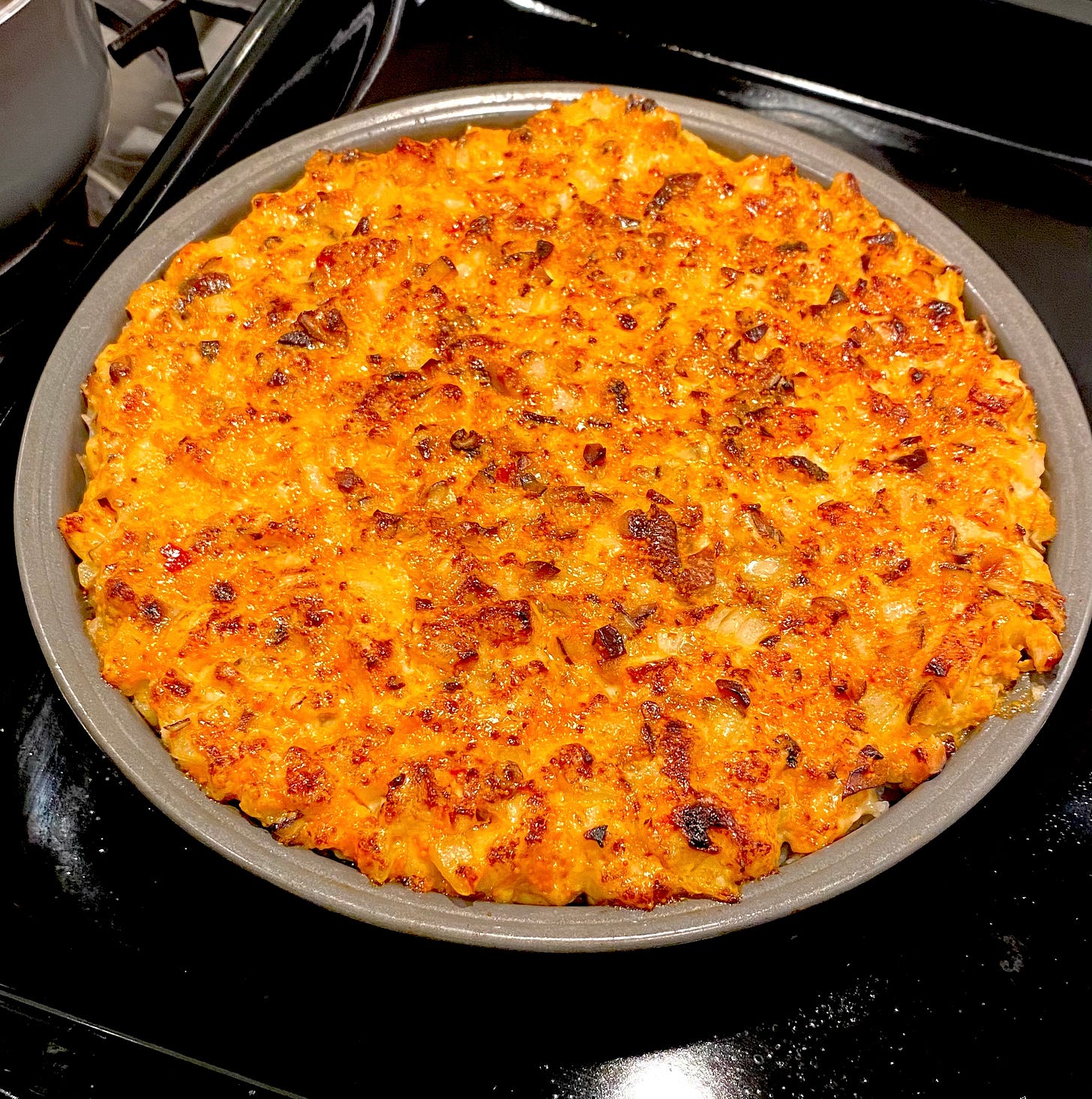

I loved reading this so much- reminds me of your bsideblogs! And the recipe sounds delicious!
So proud of you, Ben. Sounds so delicious and glad your sushi journey ended with a beautiful and tasty mouthful!